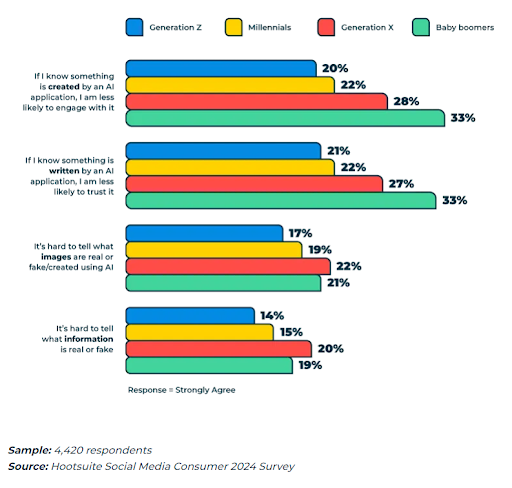Top Advertising Trends & Strategies in 2024

2023 was a weird, wonderful, and worrying year for advertisers – depending how you look at it!
You can’t talk about 2023 without mentioning generative AI. It was the year that generative AI tools broke through into the mainstream, with OpenAI’s ChatGPT racking up one million users in just five days.
Midjourney, Stable Diffusion, and other AI image generators also created a stir.
What does this new age of AI mean for advertising? We’ll explore that, along with other trends such as the move towards more authenticity and less intrusive ads.
Key takeaways:
- People are using traditional social media less, and generative AI is eroding trust in social media content. To counter declining trust, advertisers should focus on authenticity and human connection, via human and user-generated content, as well as micro-influencer campaigns.
- The shift towards B2C demand generation continues in 2024. Steps include identifying the target audience, creating engaging content, implementing a marketing funnel, continuous engagement, and utilizing native advertising.
- With privacy laws restricting third-party cookies, advertisers need to focus on engaging people with high-quality content. First-party data collection and AI tools will become crucial for effective ad targeting.
- Omnichannel marketing creates a consistent customer journey across platforms. Unify customer experience, centralize information, build trust with user-generated content, and adapt to change using automation tools.
- Advertisers will work harder than ever to overcome banner blindness, focusing on ad strategies aligned with audience values and interests. Video content, especially Click-to-Watch ads, helps overcome banner blindness by creating stronger emotional connections and engaging viewers actively.
Advertising Trends in 2024
Social Media Trust Declines Due to AI
Let’s start by looking at a trend that has been going on for a few years now – people are moving away from traditional social media platforms and trusting what they see there less.
An Outbrain-Savanta research study showed that around 21% of people plan to use social media less with 75% mistrusting ads on social media networks compared to ads shown in editorial publications.
In 2023, there was evidence to suggest that the mistrust of social networks has grown with the release of generative AI tools. In their Social Media Trends 2024 report, Hootsuite revealed that 62% of people mistrust content if they suspect it was created by an AI tool.
Older age groups are less likely to engage with AI tools and content. For this reason, it’s more important than ever to know the demographics and preferences of your target audience. For instance, it’s probably not worth marketing AI tools to over 60s as they’re less likely to be interested.

Authentic Advertising
The next logical question is – if trust in advertising is in decline, what can advertisers do about it?
In 2023, Merriam-Webster named “authentic” as the word of the year. This just shows that people are crying out for genuine human connection more than ever.
So, the simple answer is to be more authentic. In practice, it’s a bit more complex than that, especially when it comes to advertising.
The key to being more authentic is showing a human face to your brand. Brands that hide behind their corporate logo and don’t share human content are likely to fall behind.
Experiment with different types of human-generated content:
- Posts and ads that drive social change – community projects, sustainability.
- Human stories – personal customer journeys, case studies.
- Realistic content – avoid highly polished videos in favor of raw, unfiltered content
- Audience empowerment – allow your customers to speak and contribute user-generated content (UGC)
All of these types of content can form part of a more authentic advertising campaign, especially when displayed as native content or contextual ads.
A prime example of these concepts in action can be seen on the website of online-only furniture company Article. The company encourages users to add and share photos of how they use Article furniture in real life, which gives them an authentic way to showcase their items, as well as spread the word.
Teaming up with micro-influencers (people with a following between 10k and 100k) is another powerful way for brands to add an authentic and trusted voice to their marketing campaigns.
For instance, UK supermarket chain Iceland faced a problem. Their customer approval rating hit an all-time low of just 10%.
Up until then, they relied on big-name celebrities for their ads. Knowing that they needed to try something different, they switched things up. They moved to using micro-influencers rather than celebs, partnering with food influencers. The move led to an increase in user-generated content, which was then shared using native and contextual ads. The campaign paid off big time with their approval rating rocketing to 70% in just one year!
Demand Generation in B2C
In 2024, the shift towards B2C demand generation will continue. Traditionally, you wouldn’t need to generate demand in B2C and you could simply advertise your products to a hungry market.
In today’s saturated marketplace, demand generation (a strategy that originated in B2B) can help to overcome changing consumer behaviors by enabling more targeted engagement to drive demand.
Here are some basic steps to generate demand in B2C marketing:
- Identify your target audience: Focus on individuals who have specific needs or pain points that your product or service addresses.
- Develop engaging content: Create and share content that resonates with your audience’s challenges and shows you understand their pain. This can include videos, articles, blogs, or quizzes.
- Implement a marketing funnel: Use a structured approach to guide your audience through a journey towards purchasing your product, providing relevant content at each stage.
- Continuous engagement: Keep your audience engaged with reminders, offers, and additional info that reinforces your understanding of their needs.
- Use Outbrain to expand reach: Outbrain’s native advertising will showcase your content on premium news sites and publications, engaging active audiences at the start of their discovery journey.
- Conversion strategy: When users are primed to convert, ensure your product is their number one choice. Remarketing techniques on platforms like Google, Outbrain, and social media are good for capturing conversions at this late stage.
Coping with a Cookieless Future
It’s pretty certain that we’re moving towards a stricter era in digital advertising. Privacy laws are being tightened around the world, which means third-party cookies are on the way out.
Microsoft and Mozilla have already set browser defaults to ban third-party cookies and Google will be following suit in 2024.
What does this mean for advertisers?
It means letting go of an over-reliance on third-party data. Instead, focus will return to the fundamentals of creating high-quality content, engaging people well, and coming up with creative ideas.
All’s not lost on the data front though. Brands can still collect first-hand data through their website, app, and other touchpoints.
This is where AI tools can be very handy. Although you may have less data to work with when third-party cookies are gone, you have advanced AI tools in your arsenal. AI is very good at spotting patterns in the data that you wouldn’t be able to spot on your own.
Armed with first-party data and AI tools, you can still target your content and ads as effectively as before, you’ll just be applying a different approach.
Aim for Omnichannel
Speaking of different approaches, omnichannel marketing has been around for a while, but many companies still haven’t adopted it. If you’re one of those – you’re missing out.
Omnichannel is all about creating a consistent customer journey, which is what people expect these days.
Here’s how to create a winning omnichannel experience:
- Unify customer experience: You need to create a joined-up experience across platforms and devices. This means ensuring brand and UX consistency across websites, physical stores, apps, and various ad mediums.
- Centralize information: Centralize your campaigns and messaging uniformly across all channels. This ensures that no matter where your audience engages, they get the same message from your brand.
- Build trust: User-generated content is great for building trust, so make sure you’re sharing UGC on all your channels, in a consistent way.
- Adapt to change: Use the latest automation tools and tech to make life easier for you and provide a better, more targeted experience for your customers.
Overcoming Banner Blindness
People are becoming increasingly ‘blind’ to traditional advertising techniques such as display ads. This poses a problem for digital marketers. It means you can’t just put out blanket ads that will get noticed.
Fortunately, there are some strategies you can use to overcome banner blindness and get people to sit up and take notice of your brand. The main one is creating ads that align with the values and interests of your target audience. Value-driven and socially relevant ads are great for breaking through online noise.
Most people spend around 7 hours each week streaming video. Why? Because videos create strong emotional connections. Therefore, if you want to tap into this engagement potential, then video and ad carousels telling value-driven stories are a safe bet.
Another tip is to use Click-to-Watch video ads, which require the user to actively opt into the viewing experience. This means that the viewer is willingly engaged in the video, and more likely to internalize the message or even convert. These video formats will help to overcome banner blindness and make your ads more effective.
Start New Strategies NOW!
Sometimes the rate of technological change can feel overwhelming, especially in the world of online marketing. Many advertisers report a constant fear of being left behind.
But don’t worry – it’s never too late to start.
Once you begin moving with the times and implementing new strategies and tools, the more likely it is you’ll succeed.
Here are three takeaway action points to get you started:
- Use AI for enhanced personalization: Tailor your ad campaigns with AI. This means creating ads that resonate with your target audience’s specific interests and needs, leading to higher engagement.
- Adopt an omnichannel approach: Ensure a consistent experience for your customers across all platforms – your website, social media, physical stores, and ad channels. Doing so helps to build trust and engagement.
- Focus on video content: Turn to video content to capture attention. Create engaging, value-aligned click-to-watch video ads that tell your brand’s story. It’s all about building a connection, not just selling stuff.













